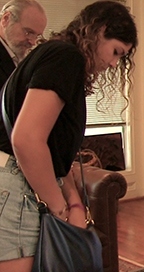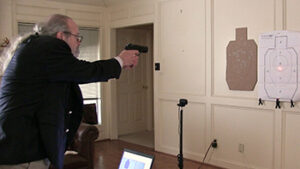by Ed Hardin (NRA Certified firearms instructor)

Just owning a gun does not mean that you are prepared to use it properly or effectively any more than owning a wrench makes you an auto mechanic.
You need to train to be prepared:
If you keep a gun in your home and/or as a carry weapon, it is because you are  aware of the possibility that bad things happen in the real world and that you need to be prepared to defend yourself and your loved ones if such a situation should arise. To be prepared to defend yourself in a life or death situation requires practice. i“While the simplest technology [target practice] may be used for practicing basic skills [trigger control, sight picture, etc], newer technologies, such as simulators, bring fresh opportunities which can help [the gun owner] develop better skills. Such types of higher level skills can only be addressed through realistic simulation training
aware of the possibility that bad things happen in the real world and that you need to be prepared to defend yourself and your loved ones if such a situation should arise. To be prepared to defend yourself in a life or death situation requires practice. i“While the simplest technology [target practice] may be used for practicing basic skills [trigger control, sight picture, etc], newer technologies, such as simulators, bring fresh opportunities which can help [the gun owner] develop better skills. Such types of higher level skills can only be addressed through realistic simulation training scenarios, which are safe re-enactments of real-life situations… There is now an increasing body of evidence to demonstrate that using simulation training can significantly enhance the level of preparedness to deal with a range of situations and help [the gun owner] develop critical skills and knowledge.” See more at SelfDefenseSoftware, developers of iFightBack software for home or classroom.
scenarios, which are safe re-enactments of real-life situations… There is now an increasing body of evidence to demonstrate that using simulation training can significantly enhance the level of preparedness to deal with a range of situations and help [the gun owner] develop critical skills and knowledge.” See more at SelfDefenseSoftware, developers of iFightBack software for home or classroom.
Simulation based training is recommended and used by Law Enforcement:
A *previous article in “PoliceLink” stressed that, “Motor skills are by their very nature perishable. They require some form of repetition or practice to maintain or improve the level of performance for each and every skill. Skills that will be performed under stress will require a higher level of repetition or intensity during their initial development and will still require constant ‘maintenance’ through physical or mental repetition; ideally a combination of both. …if you don’t consistently use and/or practice them, you won’t be able to perform them well, especially under stress.”
A *previous Law Enforcement publication wrote, “As police training moves … toward reality, it moves away from safety. For many years, police trainers could only go so far…could only be so ‘real’ without sacrificing safety.
“As long as officers were training on a real range, with real firearms, many rigid safety rules were necessary. This kept most police trainers from developing the types of training they knew their officers needed. Ultimately, technology stepped up to provide an answer, the firearms training simulator, which provided a means for conducting firearms use-of-force training.”
safety rules were necessary. This kept most police trainers from developing the types of training they knew their officers needed. Ultimately, technology stepped up to provide an answer, the firearms training simulator, which provided a means for conducting firearms use-of-force training.”
Simulation based training is recommended and used by military:
The military has also long recognized the benefits of simulation-based  training. ii“Simulation software has become an invaluable training tool for the armed forces, offering trainees a unique and comprehensive training experience whilst saving the forces both time and money.
training. ii“Simulation software has become an invaluable training tool for the armed forces, offering trainees a unique and comprehensive training experience whilst saving the forces both time and money.
“Simulation software offers trainees a realistic and immersive environment in which to practice and perfect their responses and decision-making skills.

“These powerful training platforms may not offer physical real-life experience, but they allow trainees to practice working in a huge variety of different scenarios and environmental conditions that they may otherwise never encounter during training.
Benefits of simulation based training:
“Here are 5 invaluable benefits of using simulation software [such as iFightBack]:
- Cost effective and time saving.
- Safe environment to learn in.
Simulation-based learning offers a controlled and safe environment in which to learn…giving [the gun owner] the experience and confidence they require to perform effectively when faced with the real thing. - Highly immersive experience.
- Experience a variety of environments and scenarios.
- Progress can be measured objectively.”
iii“If you are a gun owner, especially one who carries a firearm on a daily basis, you’ve probably wondered how you would fare if you had to use your weapon in a life-and-death situation. Could you hit a moving target? Would you freeze under pressure? Would you accidentally harm innocent bystanders in your attempt to take down a threat? With virtual simulation training, you can find out the answers to these questions.
“…does (taking a concealed carry class) really mean that you will be ready to use your firearm in an emergency situation? Training simulations are one way to learn a skill that is too dangerous to perform for real.”
University research demonstrates effectiveness of simulation based training:
Research at Winona State University in Minnesota states: “The intent of simulations is to immerse trainees in situations to see their real reactions, and to demonstrate what their subconscious tactical decisions might be if confronted in a similar manner. …increasing the brains’ muscle memory by using simulations, similar to athletes building muscle memory while training for competition. …allowing the trainee to make mistakes, these simulations allow for trainees to experience errors and consequences in a safe environment.
“Training with a video of a human character is more effective than training with a computer-generated character because of the realistic nature of the interaction.
“This type of learning creates appropriate and necessary memory and trains the most important law enforcement muscle of all — the brain.”
A Federal Law Enforcement Simulation Training Study concludes, “…it does appear that students training with a non-recoil handgun achieve statistically similar qualification scores that students training with a live-fire weapon achieve. In addition to the potential cost savings, (non-recoil) handgun training offers several instructional advantages and also provides a safer environment than live-fire. …several studies seem to indicate that firearm simulation is a viable approach…becoming a valuable tool in both the teaching and learning of psychomotor skills.”
iFightBack software is designed and priced for home or classroom training:
At SelfDefenseSoftware (developers of iFightBack) our motto is “Practice as if you life depended on it!” We advise that you take advantage of more than one method for training. iFightBack is simulation based software designed for home or classroom training.
Methods for training:
1) Go to the gun range as often as possible to learn and maintain your muscle memory for:
aiming
breath control
hold control
trigger control
follow-through
2) Dry Fire Practice
3) Mental Rehearsal
4) Interactive Simulation-Based Training. (at your local range or at home with iFightBack (Train your brain for better threat assessment, sight acquisition, shoot / don’t shoot, multiple threats, moving targets, good guy / bad guy determination, and much more.)
ii Benefits of Simulation-Based Training for the Armed Forces
iii Simulation Training: Are You Actually Ready to Use Your Gun in an Emergency?
* Previously published articles that are no longer on-line.









 Optionally, the
Optionally, the 
